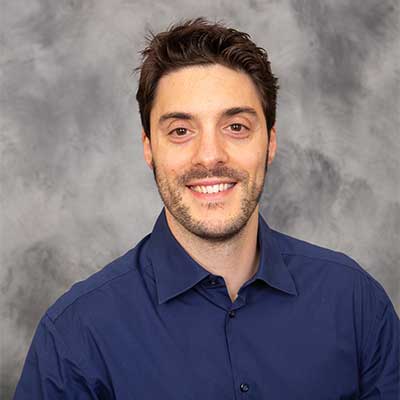
Gianluca Veggiani
Assistant Professor
Department of Pathobiological Sciences
LSU School of Veterinary Medicine
Louisiana State University
Baton Rouge, LA 70803
Education
PhD, University of Oxford (England), 2017
MSc, University of Padua (Italy), 2011
BSc, University of Padua (Italy), 2008
Research Interest
Our work is centered on developing innovative technologies to understand pathogenic mechanisms in cancer and infections, and develop novel diagnostics, vaccines, antivirals, and immunotherapies.
We use nano-immunoengineering methods and a variety of biochemical, biophysical, structural, and cell-based approaches to understand how cells rewire their signaling pathways upon malignant transformation and viral infection. We also use molecular evolution techniques such as phage-display, and CRISPR/Cas9 gene editing to identify cancer biomarkers and modulate immune signaling for novel cell-based therapies.
Awards
2020, H2i Pitch Perfect Competition for innovative and promising healthcare solutions
2016, Newsholme graduate prize for academic distinction in Biochemistry
2015-2016, Medical Research Council Doctoral Training Partnership for research excellence in Biochemistry
2012–2015, Merton College Scholarship, University of Oxford, U.K.
Selected Publications
Veggiani G†, Villaseñor R, Martyn GD, Tang QJ, Krone WM, Gu J, Chen C, Waters ML, Pearce KH, Baubec T, Sidhu SS. High-affinity chromodomains engineered for improved detection of histone methylation and enhanced CRISPR-based gene repression. Nat. Commun; 13(1):6975; 2022.
Martyn GD, Veggiani G, Kusebauch U, Morrone SR, Yates BP, Singer A, Tong J, Manczyk N, Gish G, Sicheri F, Moran MF, Moritz R, Sidhu SS. Engineering high affinity variants of human SH2 domains as affinity purification tools for mass spectrometry. ACS Chem Bio, 17(6):1472-1484; 2022.
Veggiani G, Yates BP, Martyn GD, Manczyk N, Singer A, Sicheri F, Sidhu SS. A panel of engineered ubiquitin variants targeting the family of human ubiquitin interacting motifs. ACS Chem Bio; 7(4):941-956; 2022.
Magazine N, Zhang T, Wu Y, McGee M, Veggiani G, and Huang W. Mutations and Evolution of the SARS-CoV-2 Spike Protein. Viruses; 14(3), 640; 2022.
Linossi EM*, Li K*, Veggiani G*, Tan C, Dehkhoda F, Hockings C, Calleja D, Keating N Feltham R, Brooks AJ, Li SS, Sidhu SS, Babon JJ, Kershaw NJ, Nicholson SE. Identification of a novel exosite on the SOCS2-SH2 domain that enhances its binding to phosphorylated ligands. Nat Commun; 12(1):7032; 2021.
Veggiani G, Huang H, Yates BP, Tong J, Kaneko T, Joshi R, Shawn Li S-C, Moran MF, Gish G, Sidhu SS. Engineered SH2 domains with tailored specificities and enhanced affinities for phosphoproteome analysis. Protein Sci; 28(2): 403-413; 2019.
Veggiani G, Nakamura T, Brenner M, Gayet R, Yan J, Robinson C, Howarth M. Programmable polyproteams built using twin peptide superglues. PNAS; 113(5): 1202- 1207; 2017.
Veggiani G, Zakeri B, Howarth M. Superglue from bacteria: unbreakable bridges for protein nanotechnology. Trends in Biotech; 32(10): 506-512; 2014.
Fierer JO*, Veggiani G*, Howarth M. SpyLigase peptide–peptide ligation polymerizes affibodies to enhance magnetic cancer cell capture. PNAS; E1176–E1181; 2014.
Fairhead M, Veggiani G, Lever M, Yan J, Mesner D, Robinson CV, Dushek O, van der Merwe P.A, Howarth M. SpyAvidin Hubs enable precise and ultrastable orthogonal nanoassembly. J. Am. Chem. Soc; 136(35): 12355-12363; 2014.
Jain J, Veggiani G, Howarth M. Cholesterol loading and ultrastable protein interactions determine the level of tumor marker required for optimal isolation of cancer cells. Cancer Res; 73(7):2310–2321; 2013.